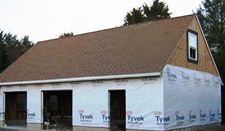Welcome to Ask the Pole Barn Guru – where you can ask questions about building topics, with answers posted on Mondays. With many questions to answer, please be patient to watch for yours to come up on a future Monday or Saturday segment. If you want a quick answer, please be sure to answer with a “reply-able” email address.
Email all questions to: PoleBarnGuru@HansenPoleBuildings.com
DEAR POLE BARN GURU:It looks like your double truss system uses hangers between the trusses rather than the boards running on top of the trusses.
When I see these used on decks it sometimes looks like the nails that are toe-nailed into the connectors don’t do anything as they are at the very end of the board. The board splits or chips out.
Have I just seen it done improperly or perhaps I’ve seen the wrong types of hangers or nails being used?
I’m guessing you’ve seen your fair share of improperly installed connectors so I’m looking forward to what you have to say.
Thanks NOVICE IN MILTON
DEAR NOVICE: The Hansen Pole Buildings double truss system (as well as the special requests we get for widely spaced single trusses) do utilize engineered steel connectors to attach the roof purlins to the sides of the trusses.
As an experiment, I looked today at the hundreds of hangers we have installed on a 42’ x 120’ self storage building being constructed for Eric (one of the Hansen Pole Buildings owners). All of the hangers for the project are manufactured by Simpson Strong-Tie:
https://www.hansenpolebuildings.com/blog/2013/08/simpson/
The hangers installed are their LU26, LU28 and H1 brackets.
The roof purlins being nailed into are kiln dried 2×6 and 2×8 of Douglas Fir (DFir) and SPF (Canadian Spruce-Pine-Fir). All of the nails used in the hangers are joist hanger nails (#10 x 1-1/2” long) which are designed specifically for use in engineered metal connectors.
https://www.hansenpolebuildings.com/blog/2013/01/tico-10d-common-nails/
I was unable to find a single case on Eric’s large building with hundreds of joist hangers where the nails contributed to an end split in a purlin or a portion of the roof purlin being split away.
I do have some theories as to what may be the cause of what you have seen on decks.
Theory #1 – other than a few specially designed brackets, joist hangers are designed for the nails to be installed at right angles to the wood. Toe-nailing (driving the nails in at an angle) could be responsible for splits.
Theory #2 – in your part of the country, the vast majority of lumber used for decks is pressure preservative treated Southern Yellow Pine (SYP). It could very well be the SYP lumber is more susceptible to splitting than the species of wood provided for use in the building we are currently constructing.
Simpson Strong-Tie produces millions upon millions of engineered steel connectors every year – if there existing an inordinate (or any) number of failures due to the use of their products, they would be on top of making changes in the design to prevent them.
Me – if my choice is to nail a purlin over the top of the truss (which in the great majority of cases does not calculate out to be adequate structurally) or to use an engineered connector – the connector is going to win every single time.
DEAR POLE BARN GURU: I am currently assembling a Hansen Pole Building kit package. The building has a transition in roof slope from a steeper slope in the enclosed area, to a flatter slope in the open attached side shed.
In following the instructions in your Construction Guide, I note the solid wall between the enclosed and open portions is to have the wall framed and wall steel installed prior to placement of the roof steel.
My questions are these – I’m running the J trim at the top eave girt between the enclosed wall and shed. Do I need to flow around the shed rafters with the J trim? Will I be able to square the roof if I put the wall steel on? STUMPED
DEAR STUMPED: Yes – the J Trim goes around the rafters which project through the wall. And as long as this wall is plumb before installing the wall steel, it will not interfere with being able to square up the roof.







